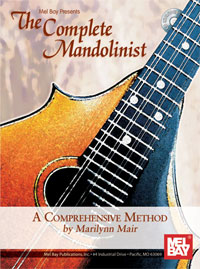based on an article that originally appeared in “Mandolin Magazine,” Fall 2003.
Download the pdf for the sheetmusic associated with this article: Duet in G
In July, 2003, I spent a week as “Celebrity Guest of the Week” on the Comando listserv, answering question on all sorts of topics. The one that generated the greatest dialogue was right hand technique. Initially replying to a question from a Comandoleer on the mechanics of a good right hand technique, I gave a simple example: “Place your pick on your D string, keep your wrist loose and pick down (dropping your hand from the wrist, not the elbow) until the pick rests on the A string”.
The first phrase of emphasis was “keep your wrist loose” as I was writing about eliminating unnecessary tension from your arm and hand, to avoid injury and increase speed. The secondary emphasis was “from the wrist, not the elbow,” making the point that good picking doesn’t involve a pump-from-the-elbow movement. The 3rd idea was “until the pick rests on the A string,” introducing a hand position that uses effort efficiently, and precludes the upward flourish of the pick away from the neck after playing a note that wastes time and effort unnecessarily avoiding the next string.
The idea that this technique involved a “rotation” of the right forearm was introduced in a follow-up question, one that delighted me because it seemed that whoever asked it had tried and analysed the movement. I usually sidestep the word “rotation” when I teach pick technique, because “drop-lift” is more accurate, and “rotate” is so easy to misinterpret. And the “drop-lift” vs “rotate” debate did spiral onward with list members, reminding me that “rotation,” like cholesterol, can be “good” and “bad”.
I attempted to clarify my response, and am including much of my answer here because I think the concept of classical right hand technique is generally misunderstood. It’s difficult to pinpoint subtle 3-D movements in 2-D words, and sometimes easier to describe how to avoid inefficient technique than to tell players I can’t see that, yes, they have got it right. So I’ll give some examples of how not to use your right hand, in hopes that this will help narrow the field of possibilities you have to explore in trying to optimize your own technique.
To develop a good, efficient, fast right hand, you want to avoid unnecessary arm tension and maintain an easy motion in your wrist joint. Here are some techniques you should try to avoid. Try them so you’ll be able to recognize them if they pop up in your playing. First “wrong” technique: hold your pick and mandolin as if you were about to play a note, and squeeze your pick really hard. Notice how your thumb freezes, the top of your wrist locks, and the only way to move your pick up and down is to “push” and “pull” it by moving from the elbow. You do not want this as part of your right hand technique, so avoid holding the pick too tightly.
Now, as an experiment, place your forearm, pick in hand, palm down, on a table, with your wrist bones supported by the edge of the table and your hand extending off the table. To move your hand left-and-right, you have to “waggle’ your hand back and forth, using none of the muscles in your forearm, because they’re immobilized by the table. You also do not want this as part of your right hand technique. Why? Because it’s an inefficient use of the wrist joint. Try “waggling” your wrist right and left very fast. Notice how quickly you lose control and regularity of motion?
Return to playing position. Be sure you are sitting up straight and holding your mandolin parallel to your body. “Place your pick on your D string, keep your wrist loose and pick down (dropping your hand from the wrist, not the elbow) until the pick rests on the A string”. Be sure you’re “dropping” not “waggling” your hand. You’ll see, if you look at your wrist, that while dropping your hand so your pick falls unimpeded into the next string, and lifting your pick back up to drop it again, working efficiently with gravity, that you are actually executing a more complex motion. You are using the long muscles of your forearm to control your pick motion, and while executing the drop-lift, your arm incorporates a slight rotation. You are not trying to rotate, you are trying to drop-lift with a loose wrist, but the slight rotation occurs naturally. Now you can begin to experiment to find the variation of this that works for you.
One more point: some folks on the Comando discussion stated that this was a “slow” technique. That’s simply not true. Quite the contrary, it has the potential to be wicked fast. A good tremolo is so fast it obscures the individual notes to create a shapeable melodic line. It is faster than you can count! Increasing speed should be easy, and you increase or decrease the nps (notes per second) in tremolo to shape your tone. Increasing speed on single-note passages requires a more efficient coordination between your two hands. With this technique you’ll actually have to slow your right hand down to match what your left hand can do, depending on the difficulty of the left hand run. But remember, a good right hand technique is crucial to progressing as a mandolinist, so spend some time investigating the pros and cons of yours.



